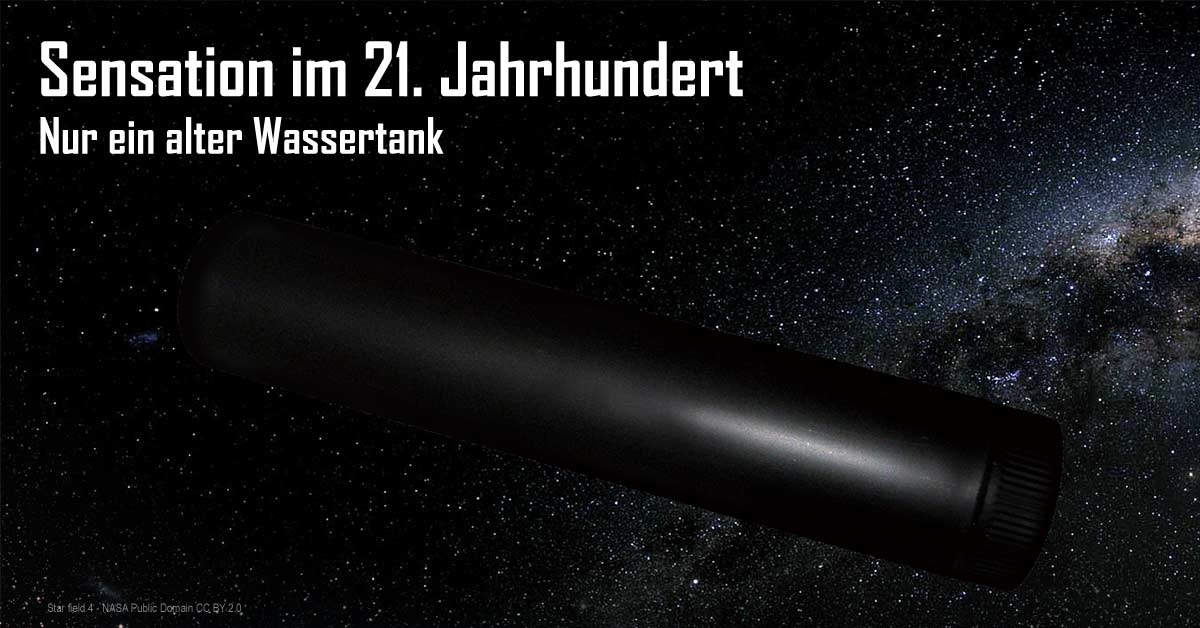
2493 Oumuamua war ein Alien-Artefakt

Im Jahr 2017 durchquerte ein extrasolarer Komet das Sonnensystem. Er kam mit einer so hohen Geschwindigkeit, dass sein Ursprung außerhalb des Sonnensystems sein musste. Das Objekt bekam den Namen Oumuamua. Es wurde erst als interstellarer Asteroid klassifiziert. Später wurde er als Komet eingeordnet, da geringe Änderungen der Trajektorie auf Ausgasungen hindeuteten.
Das wirklich Erstaunliche war seine Form. Die damaligen Astronomen konnten in ihren Teleskopen nur einen Punkt sehen. Aber der Punkt blinkte. Daraus schloss man, dass Oumuamua schnell rotiert. Aus dem Helligkeitsverlauf konnte man berechnen, dass Oumuamua mindestens 5-mal so lang wie breit war, eine Zigarrenform von etwa 250 x 50 x 50 Meter. Die schnelle Rotation sprach für einen massiven Körper, denn bei seiner geringen Gravitation musste das Objekt aus einem massiven Stück bestehen. Sonst wäre es durch die Fliehkräfte längst auseinandergefallen. Leider konnte man das nicht direkt nachprüfen. Für eine Rendezvous-Mission war Oumuamua viel zu schnell. Es gab keine Sonde in der Nähe. Man konnte ihn nicht besuchen.
Spektroskopie zeigte einen hohen Metallanteil. Schon früh gab es Vermutungen, dass Oumuamua künstlichen Ursprungs sein könnte. Radioempfänger wurden ausgerichtet und bei seinem minimalen Erdabstand von 33 Millionen Kilometer hätte man Sender bis zu einem Zehntel Watt empfangen. Aber es gab keine aktiven Emissionen. Oumuamua verschwand schnell wieder in den Tiefen des Alls und geriet in Vergessenheit. Jedes Jahr wuchs der Abstand um fast eine Lichtstunde, für Jahrhunderte.
Im Jahr 2493 ist Oumuamua fast 400 Milliarden Kilometer entfernt. Das sind zwei Lichtwochen oder 2700 Astronomische Einheiten (AU), 2700-mal so weit von der Sonne, wie die Erde, weit in der Oortschen Wolke. Aber das ist eine Distanz, die experimentelle Antriebe nach dem Raumkrümmer-Prinzip inzwischen schaffen. Eine Expedition macht sich auf, den alten Kometen zu besuchen. Die größte Schwierigkeit liegt nicht darin, den Kometen einzuholen, sondern ihn dann im Zielgebiet aufzuspüren. Richtung und Geschwindigkeit wurden im 21. Jahrhundert genau vermessen. Der Vektor ist ziemlich gut bekannt. Und wenn die Bahn nicht gestört wurde, dann sollte sich Oumuamua in einem Raumvolumen von drei Kubik-AU oder 10 hoch 25 Kubikkilometern befinden. Optisch ist der Komet nicht aufzuspüren. Dort draußen bekommt er Milliarden mal weniger Licht als die Erde und er ist außerdem ziemlich schwarz. Aber mit Radar kann man ihn finden. Die Mission bringt im Zielgebiet mehrere starke Radarsender aus und wartet auf Echos. Nachdem man das mehrmals wiederholt hat, detektiert man ein Signal am Rand des Suchraumes. Die Flugzeit ins Zielgebiet über 2700 AU hatte acht Tage gedauert, die anschließende Suche 40 Tage.
Das Forschungsschiff nähert sich Oumuamua. Endlich kann man das Objekt wirklich in Augenschein nehmen. Man muss es mit Scheinwerfern beleuchten, ein schwarzer Brocken in der Schwärze des Alls. Die Oberfläche ist sehr glatt. Es ist keine Zigarrenform, wie früher angenommen, sondern ein Zylinder. Oumuamua ist eindeutig künstlicher Herkunft. Er ist ein perfekter Zylinder, fast 400 Meter lang und 50 Meter im Durchmesser. Auf den ersten Blick wirkt er wie ein leerer Treibstofftank. Eine genauere Untersuchung zeigt im Inneren Reste von Wassereis. Das war die Quelle der vor Jahrhunderten vermuteten Ausgasungen. Die Oberfläche hat unzählige Einschläge von Mikrometeoriten und Staub. Eine statistische Analyse der Oberfläche ergibt ein Alter von 150 Millionen Jahren. Oumuamua ist eines der ältesten Produkte einer technischen Zivilisation, die jemals entdeckt wurden.
Das Objekt hat einige kleinere Ausbuchtungen und Halterungen, aber – abgesehen von den Meteoriteneinschlägen – keine Schäden. Oumuamua wurde anscheinend absichtlich freigesetzt und nicht durch einen Unfall abgesprengt. Vor 150 Millionen Jahren war er Teil einer größeren Struktur, einer Raumstation, eines Schiffs oder eines Habitats. Oumuamua diente vermutlich als Wassertank. Nachdem der Tank geleert war, scheint er abgetrennt worden zu sein und ist seitdem auf seiner Trajektorie verblieben.
Oumuamua entfernt sich zwar schnell mit 26 Kilometer pro Sekunde vom Sonnensystem. Aber trotzdem hat er eine ähnliche Umlaufbahn um das galaktische Zentrum, wie unsere Sonne. Die Relativgeschwindigkeit ist klein gegenüber der gemeinsamen Geschwindigkeit um das Zentrum der Milchstraße (ca. 225 km/s). Die Sonne ist selbst auch etwa 20 km/s schneller als die mittlere Geschwindigkeit der Sterne in ihrer Umgebung.
Die aktuelle Relativgeschwindigkeit von Oumuamua zum Sonnensystem bedeutet nicht, dass sich damals eine technische Konstruktion mit 26 km/s Fluchtgeschwindigkeit bewegte. Vielleicht war sie fast in Ruhe gegenüber ihrem Ursprungssystem. Vielleicht gehörte Oumuamua den Bewohnern eines dortigen Oort-Objekts. Seit damals haben sowohl Sol als auch Oumuamua das galaktische Zentrum zu zwei Dritteln umrundet und auf dem Weg durch gravitative Wechselwirkungen mit anderen Sternen immer wieder leicht die Richtung geändert. Die Relativgeschwindigkeit ist nur die Folge eines anderen Richtungsvektors bei im Wesentlichen ähnlicher Geschwindigkeit.
Letztlich ist Oumuamua ein uraltes Stück Schrott, das zufällig das Sonnensystem durchquerte. Astronomen im 21. Jahrhundert mussten annehmen, dass es sich um ein natürliches Objekt handelt. Alles andere wäre als Science-Fiction und als Wunschdenken bezeichnet worden.
Im 21. Jahrhundert wusste man noch nicht, wie weit verbreitet technische Zivilisationen tatsächlich sind, wie lang es sie schon gibt und wie gigantisch ihre Operationen sind im Vergleich zu planetengebundenen Gesellschaften. Moderne technische Zivilisationen haben eine millionenfach höhere industrielle Kapazität als die Erde des 20. Jahrhunderts. In hunderten Millionen Jahren gab es Millionen solcher Zivilisationen. Im Lauf der Zeit haben alle zusammen viele Billionen Billionen Objekte wie Oumuamua hinterlassen. Das ist eine Größenordnung, die schon fast an die Zahl natürlicher Irrläufer in der Galaxie heranreicht.
Es war nur ein Zufall, dass der erste interstellare Besucher ein technisches Relikt war. Viele andere Irrläufer, die später das Solsystem besuchten, waren natürlichen Ursprungs.
Mehr Entdeckungen
2312 Kaio-Artefakt
2412 Pontos Mission
2493 Oumuamua
2501 Extraplanetare Forschung
2638 Gas-Wesen
2668 Ultrametalle
2681 Roboterzivilisation
2776 Höhlensysteme
2834 Generationsschiffe
2841 Leuchtender Tempel
2844 Digitale Entdeckung
2860 Deepspace-Grid
2870 Overlay KI Zivilisation
2873 Entdeckung im Weltraum
3042 Galaxien
3131 Roboter und Drachen
3270 12.000 Jahre Geschichte
3359 Survivalisten in Not
Neue Beiträge
2158 Space Patrol
2222 Weltraumpiraten
2326 Kein interplanetarer Krieg
3050 Königliche Garde
3090 Solo Ehre
2234 Am Ende des Orbits
2248 Gemini-Katastrophe
2366 Orbitale Ökonomie
2312 Kaio-Artefakt
3361 Erste Menschheit
2333 Metrische Impulsverstärkung
2337 Verschwörung im Orbit
2247 Quantensprung
2284 Trennung der Erde
2321 Isolation der Erde
2205 Unternehmensnationen
2192 Antiexpansionistischer Terror
2179 Private Asteroidenbasis
2231 Vereinte Planeten
2291 Verbotene Forschung
Die Besten
(20 von 75)
2091 Baum des Lebens
2135 Sonnenschirm für die Erde
2205 Unternehmensnationen
2222 Weltraumpiraten
2265 Öko-Militarismus
2337 Verschwörung im Orbit
2412 Pontos Mission
2493 Oumuamua
2501 Extraplanetare Forschung
2668 Ultrametalle
2720 Spacedom-Tragödie
2722 Sein Leben für die Kinder
2750 VR-Drama Executive Decision
2786 Nette Aliens
2949 Königin von Marduk
2997 Alien-Religionen im Streit
3110 Zersplitterung des äußeren Systems
3131 Roboter und Drachen
3190 Überraschungsangriff
3191 Umzug nach Cobol
 2491
Forschung entdeckt Multitasking Gen
2491
Forschung entdeckt Multitasking Gen

 2495
Jamaliya Verschwörung
2495
Jamaliya Verschwörung